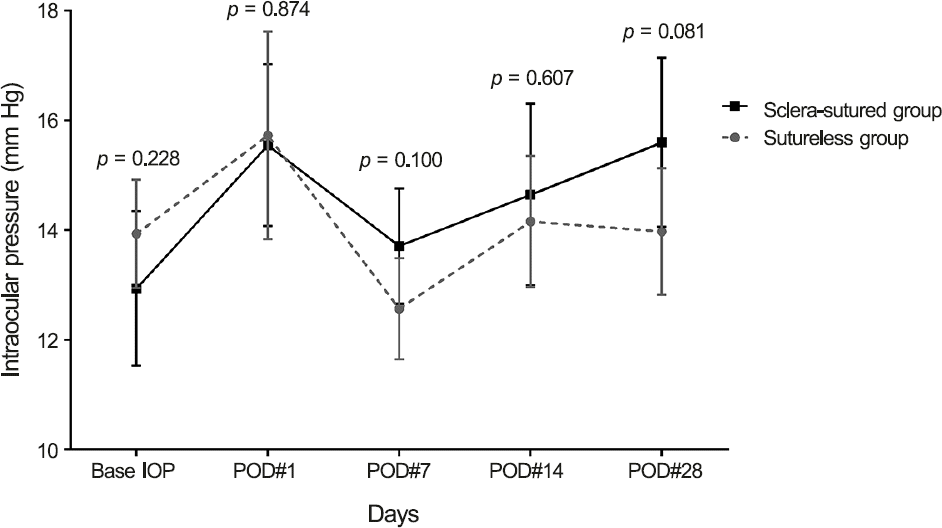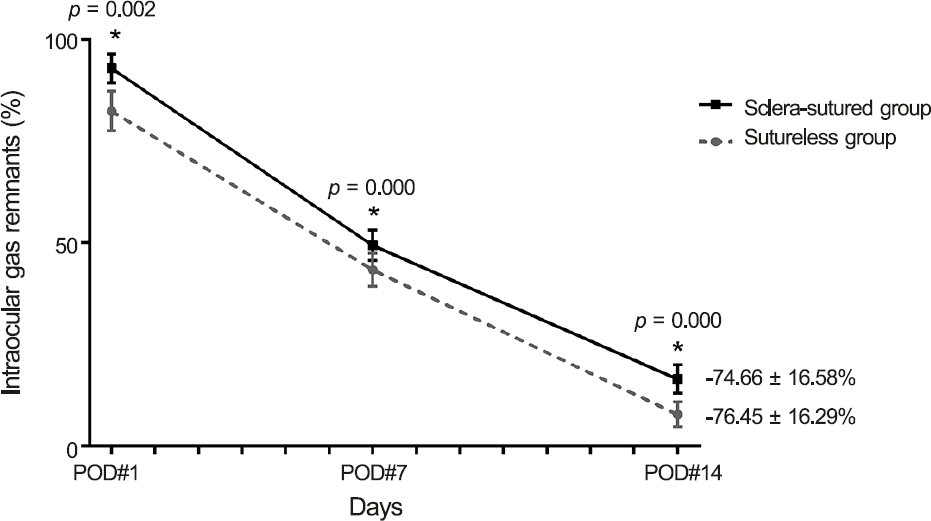Abstract
Purpose
To evaluate the effects of scleral suture for the sclerotomy wound leakage and the clinical outcomes in 23-gauge trans-conjunctival sutureless vitrectomy with fluid-air exchange.
Methods
A retrospective, comparative chart review of 75 eyes of 75 patients who underwent 23-gauge transconjunctival vi-trecomy with fluid air exchange was performed. The patients were divided into 2 groups according to the scleral suture used at the end of the operation, sclera-sutured group and sutureless group. The amount of intraocular gas remnants was measured to compare the degree of sclerotomy wound leakage and the postoperative intraocular pressure (IOP) and reoperation rate were analyzed.
Results
The mean IOP on postoperative day 1, 7 and 14 was 15.5 ± 4.0 mm Hg in the sclera-sutured group and 15.8 ± 6.2 mm Hg in the sutureless group, without statistical difference ( p = 0.874). The percentage of intraocular gas remnants in eyes on post-operative day 1 was significantly higher in the sclera-sutured group (92.9 ± 9.7%) than in the sutureless group (82.4 ± 16.2%; p = 0.002) as well as on postoperative days 7 and 14. The reoperation rate was not statistically significantly different between the sclera-sutured group (6.5%) and sutureless group (9.1%; p = 0.683)
Conclusions
In the cases of 23-gauge sutureless vitrectomy with fluid-air exchange, the scleral suture may be effective to pre-vent the sclerotomy wound leakage and maintain the intraocular gas longer, but there was no statistically significant difference in the final success rate between the 2 groups. However, as more intraocular gas remained in the sclera-sutured group than in the sutureless group statistically, the scleral suture should be considered in cases that require long-term gas tamponade.
Go to : 
References
1. Scott IU, Flynn HW Jr, Dev S. . Endophthalmitis after 25- gauge and 20-gauge pars plana vitrectomy: incidence and outcomes. Retina. 2008; 28:138–42.
2. Kellner L, Wimpissinger B, Stolba U. . 25-gauge vs 20-gauge system for pars plana vitrectomy: a prospective randomized clin-ical trial. Br J Ophthalmol. 2007; 91:945–8.
3. Kunimoto DY, Kaiser RS. Wills Eye Retina Service. Incidence of endophthalmitis after 20- and 25-gauge vitrectomy. Ophthalmology. 2007; 114:2133–7.
4. Parolini B, Romanelli F, Prigione G, Pertile G. Incidence of en-dophthalmitis in a large series of 23-gauge and 20-gauge trans-conjunctival pars plana vitrectomy. Graefes Arch Clin Exp Ophthalmol. 2009; 247:895–8.

5. Kim HJ, Hong S, Park YS, Sohn JH. Comparison of intraocular pressure between sutureless and sutured 23-gauge vitrectomy. J Korean Ophthalmol Soc. 2010; 51:835–41.

6. Woo SJ, Park KH, Hwang JM. . Risk factors associated with sclerotomy leakage and postoperative hypotony after 23-gauge transconjunctival sutureless vitrectomy. Retina. 2009; 29:456–63.

7. Kim OJ, Lee TG, Na SJ. Primary 23 gauge transconjunctival su-tureless vitrectomy with air tamponade for simple rhegmatogenous retinal detachment. J Korean Ophthalmol Soc. 2011; 52:190–6.

9. Parver LM, Lincoff H. Mechanics of intraocular gas. Invest Ophthalmol Vis Sci. 1978; 17:77–9.
10. Gupta OP, Ho AC, Kaiser PK. . Short-term outcomes of 23-gauge pars plana vitrectomy. Am J Ophthalmol. 2008; 146:193–7.

11. Acar N, Kapran Z, Unver YB. . Early postoperative hypotony after 25-gauge sutureless vitrectomy with straight incisions. Retina. 2008; 28:545–52.

12. Shunmugam M, Shunmugam S, Williamson TH, Laidlaw DA. Air-gas exchange revaluated: clinically important results of a com-puter simulation. Invest ophthalmol Vis Sci. 2011; 52:8262–5.
Go to : 
 | Figure 1.The preoperative and postoperative mean intraocular pressures. There is no statistically significant difference be-tween the sclera-sutured group and the sutureless group during the whole period ( p-value < 0.05 by paired t-test). Error bars indicate 95% confidence interval of means. IOP = intraocular pressure; POD = postoperative day. |
 | Figure 2.The postoperative mean amounts of intraocular gas remnants.There is no statistically significant difference in the mean rate of intraocular gas reduction between 2 groups. Error bars indicate 95% confidence interval of means. POD = postoperative day. * Significant difference between the sclera- sutured group and the sutureless group on postoperative day 1, 14, and 28 ( p-value < 0.05 by paired t-test). |
Table 1.
General characteristics of patients (eyes)
| Sclera-sutured group | Sutureless group | p-value∗ | |
|---|---|---|---|
| Number of patients (eyes) | 31 | 44 | |
| Mean age ± SD (years) | 56.7 ± 11.5 | 58.7 ± 9.4 | 0.410 |
| Gender (male:female) | 13:18 | 24:20 | 0.288 |
| Laterality (right:left) | 18:13 | 22:22 | 0.497 |
| Preoperative IOP (mm Hg) | 12.9 ± 3.8 | 13.9 ± 3.2 | 0.228 |
| Combined phacoemulsification | 17 | 26 | 0.718 |
| Indication of vitreoretinal surgery (RRD:M.H) | 20:11 | 30:14 | 0.744 |
Table 2.
Postoperative mean intraocular pressure




 PDF
PDF ePub
ePub Citation
Citation Print
Print


 XML Download
XML Download